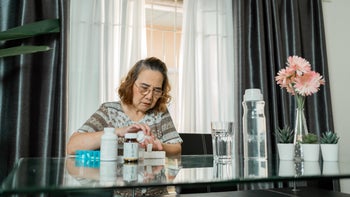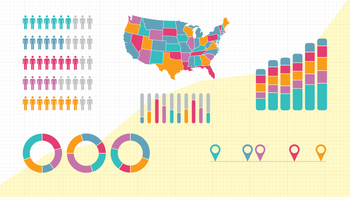6 Farxiga Interactions You Should Know About
Key takeaways:
Farxiga (dapagliflozin) is a medication used to treat conditions like Type 2 diabetes, chronic kidney disease, and heart failure. It interacts with several medications.
Farxiga interacts with insulin and medications that signal the body to release insulin. Combining Farxiga with diuretics (water pills) or lithium (Lithobid) can also be problematic.
You should avoid or limit alcohol while taking Farxiga. Drinking can raise the risk of rare but serious Farxiga side effects, including dehydration, low blood sugar (glucose), and ketoacidosis (too much acid in the blood).
Access savings on related medications
Table of contents

Farxiga (dapagliflozin) is an oral medication that can help treat Type 2 diabetes, heart failure, and chronic kidney disease. It belongs to a class of medications called sodium-glucose co-transporter-2 (SGLT2) inhibitors, sometimes called “flozins.” It primarily works by helping the kidneys get rid of extra blood sugar (glucose).
Because Farxiga works through the kidneys and lowers blood sugar, it can interact with other medications that affect the kidneys or blood sugar. And knowing about Farxiga interactions can help you stay safe while taking your medication.
Farxiga interactions
The following medications and substances can interact with Farxiga:
Diuretics (water pills), such as hydrochlorothiazide (Microzide)
Sulfonylureas, such as glyburide (DiaBeta, Glynase)
Meglitinides (also called glinides), such as repaglinide
Lithium (Lithobid)
Alcohol
Search and compare options
This isn’t a complete list. So be sure to check with your prescriber and pharmacist before starting a new medication with Farxiga. Sharing a medication list with your healthcare team can help them spot and manage interactions more easily.
Below, we’ll discuss six Farxiga interactions worth knowing.
1. Water pills like hydrochlorothiazide
Water pills, such as hydrochlorothiazide and furosemide (Lasix), are often taken to lower blood pressure or remove extra fluid from the body. People with heart failure commonly take water pills. Farxiga is also prescribed for some types of heart failure, so some people may take both a water pill and Farxiga. But they do interact with each other.
Water pills and Farxiga both cause you to urinate more often as a side effect. While this could be beneficial when treating heart failure, it could also become problematic. Taking both medications can increase the risk of dehydration. This can lead to dizziness, weakness, or low blood pressure.
Talk to your prescriber if you start noticing dark-colored urine or a sudden decrease in urination. These are symptoms of dehydration. You may need dose adjustments for either Farxiga or your water pill.
2. Insulin
Insulin is a widely used diabetes medication. It helps lower blood sugar. But sometimes, it can lower sugar too much and cause hypoglycemia (blood sugar lower than 70 mg/dL). When taken by itself, Farxiga has a low risk of causing low blood sugar. But taking both Farxiga and insulin can make this side effect more likely.
If you’ve been prescribed both Farxiga and insulin, your prescriber has likely already made dose adjustments to help prevent low blood sugar. But if you notice more frequent episodes of low sugar after starting the combination, let them know. Further medication changes may be needed.
3. Sulfonylureas like glyburide
Sulfonylureas, such as glyburide and glipizide (Glucotrol XL), are a class of medications prescribed for Type 2 diabetes. They work by signaling your pancreas to release insulin. Because of this, they carry a risk of low blood sugar. Similar to insulin, taking a sulfonylurea with Farxiga can make this side effect more likely.
Your prescriber may have you check your blood sugar more often after starting this combination. If you experience low blood sugar, be sure to treat it quickly. And let your prescriber know if you notice lows more often after starting Farxiga and a sulfonylurea. They may recommend dose changes.
More about side effects: Many Farxiga (dapagliflozin) interactions raise the risk for certain side effects, such as dehydration or low blood sugar (glucose).
The right dose: Learn about Farxiga’s recommended dosages and what to do if you miss a dose.
Compare the options: Farxiga is one of several sodium-glucose cotransporter-2 (SGLT2) inhibitors. Read about several popular SGLT2 inhibitors and ways you can save on them.
4. Glinides
Glinides, such as repaglinide and nateglinide, are another group of Type 2 diabetes medications. They work a lot like sulfonylureas. So they carry similar risks, including low blood sugar. Taking Farxiga with glinides increases the risk of this side effect.
Your prescriber may make dose changes when you first start taking these medications together. Be sure to check your blood sugar at home as instructed. And let your healthcare team know if you start having low blood sugar episodes. They may recommend dose changes to Farxiga, your glinide, or both.
5. Lithium
Lithium is a medication that can be prescribed for people living with bipolar disorder. It’s notorious for having many interactions. What’s more, minor changes in lithium dosages can greatly affect how it works in the body. Farxiga has the potential to make lithium less effective.
Lithium is removed from the body by the kidneys. So medications that run through the kidneys, including Farxiga, may interact with lithium. In this case, Farxiga can cause lithium to leave the body faster than expected. This can lower lithium levels, potentially making it less effective.
This Farxiga interaction likely wouldn’t require you to stop either medication. Your prescriber may recommend more frequent blood tests to check your lithium levels right after starting the combination. If they notice lower lithium levels, they’ll likely raise your dosage.
Let your healthcare team know if you notice worsening bipolar disorder symptoms. This can point to a potential interaction.
6. Alcohol
Alcohol and medications don’t typically mix well. And when it comes to Farxiga, drinking can raise your risk of serious side effects. This is especially true when it comes to heavy or chronic alcohol consumption.
Combining Farxiga and alcohol raises the risk of:
Dehydration: Farxiga and alcohol can each cause dehydration on their own. The risk of this side effect goes up if you combine them.
Low blood sugar: Alcohol can cause your blood sugar to drop too low. Adding diabetes medications, such as Farxiga, can raise your risk of experiencing low blood sugar. And drinking alcohol can mask symptoms of this side effect, making it harder to tell if you’re experiencing it.
Ketoacidosis: Farxiga can cause ketoacidosis, though this is very rare. This is a potentially life-threatening side effect that causes your blood to become acidic. Heavy alcohol use or alcohol use disorder can make ketoacidosis more likely to happen.
It’s best to avoid alcohol while taking Farxiga. But if you’re going to have an occasional drink, try to stay hydrated and don’t drink on an empty stomach. Be sure to check your blood sugar before, during, and after drinking, too.
Frequently asked questions
There are certain vitamins and supplements you may want to avoid while taking Farxiga. These supplements generally aren’t recommended for people living with diabetes. Notable ones include niacin (vitamin B3), ginseng, and chromium. Some supplements can raise your blood sugar levels. Others can lower it. If you have diabetes, always ask your pharmacist and prescriber before starting any vitamin or supplement.
No, Farxiga isn’t a “high-risk” medication. High-risk medications are those that can cause serious harm with small dose changes or if you take it by mistake. Farxiga isn’t included in this category.
But this doesn’t mean Farxiga is risk free. Farxiga can cause side effects. Common ones include having to urinate more often and a higher risk of urinary tract or genital yeast (fungal) infections.
The bottom line
Farxiga (dapagliflozin) is a medication used to treat Type 2 diabetes, heart failure, and chronic kidney disease. It interacts with insulin, sulfonylureas, and meglitinides (also called glinides). Farxiga also interacts with diuretics (water pills) and lithium (Lithobid). Complications from these interactions can usually be avoided with proper monitoring and dose changes. You should also limit or avoid alcohol while taking Farxiga.
Speak with your healthcare team if you notice more side effects than usual after combining Farxiga with your other medications. This could indicate an interaction. If anything seems severe or life-threatening, get medical help right away.
Why trust our experts?



References
AstraZeneca Pharmaceuticals. (2022). Farxiga- dapagliflozin tablet, film coated [package insert].
Guardado-Mendoza, R., et al. (2013). The role of nateglinide and repaglinide, derivatives of meglitinide, in the treatment of type 2 diabetes mellitus. Archives of Medical Science.
Institute for Safe Medication Practices. (2018). ISMP list of high-alert medications.
Padda, I.S., et al. (2023). Sodium-glucose transport protein 2 (SGLT2) inhibitors. StatPearls.
Scholtes, R. A., et al. (2021). Natriuretic effect of two weeks of Dapagliflozin treatment in patients with Type 2 Diabetes and preserved kidney function during standardized sodium intake: Results of the DAPASALT trial. Diabetes Care.
Tang, J., et al. (2022). Effects of sodium-glucose cotransporter 2 inhibitors on water and sodium metabolism. Frontiers in Pharmacology.
Was this page helpful?
Compare other diabetes-type-2 drugs
Related Articles
Browse medications
View AllResearch prescriptions and over-the-counter medications from A to Z, compare drug prices, and start saving.





















